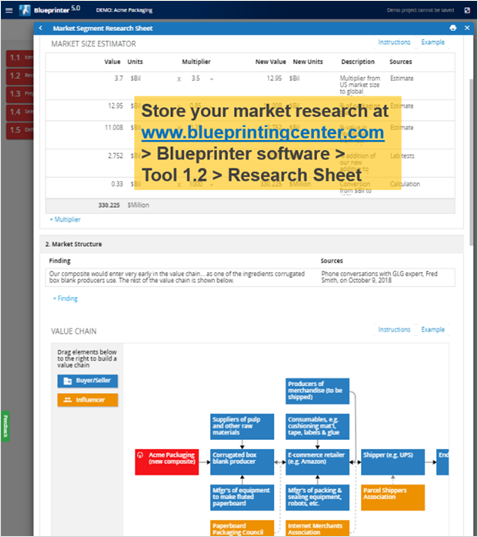- BLUE HELP
- Market Segmentation (Step 1)
- How to conduct secondary market research
-
Blueprinting Center & Methodology
- What is New Product Blueprinting?
- How is Blueprinting learned and applied?
- Blueprinting Center
- Blueprinting E-Learning Course
- How can I become Certified in New Product Blueprinting?
- How does Blueprinting fit with a stage-and-gate process?
- How does Blueprinting fit with strategic planning?
- How does Blueprinting fit with Design Thinking?
- How does Blueprinting fit with Lean Startup?
- How does Blueprinting fit with Minesweeper de-risking?
- How does Blueprinting fit with LaunchStar product launch?
- What innovation metrics should we use?
- What is "Jobs-to-be-Done?"
-
Blueprinter® Software
-
Market Segmentation (Step 1)
-
Discovery Interviews (Step 2)
- How to plan Discovery interviews
- Preparing your interview team
- Convincing customers to be interviewed
- How to handle confidential info in an interview
- How to conduct a Discovery interview
- Finding & using a digital projector for interviews
- How to conduct a customer tour
- How to debrief & follow-up a Discovery interview
- Engaging your sales colleagues in interviews
- Engaging distributors in interviews
- Interviewing customers down the value chain
- How to interview remotely with web-conferences
- How to interview at trade shows & other venues
- Interviewing in different global cultures & languages
- How to listen well during customer interviews
- How to probe during customer interviews
- How to gather economic data during interviews
- How to create & use Current State questions
- How to identify Must Haves (MH)
- How to select Top Picks (TP)
- How to use Trigger Maps
- How to form Outcome Statements
-
Preference Interviews (Step 3)
-
Rest of Blueprinting (Steps 4-7)
-
Everyday VOC
-
Minesweeper® De-risking
3. Where to store your secondary market research
Many companies spend a bundle on secondary market research… and then spend it again… and again. That’s because they haven’t figured out how to store their research so everyone can find it. You can do better using two features in Blueprinter software. For more on this, visit www.blueprintingcenter.com > Blueprinter Software > Step 1. Here are the two approaches you can use:
The first is Blueprinter Tool 1.2: Record Secondary Market Research in your Blueprinter software. This displays all the market segments your team is thinking about pursuing. For each market segment, you can open a “Research Sheet.” Here’s where you can store all the information you’ve learned through your secondary research:
- Market Size
- Market Structure
- Market Trends
- Market Growth
- Supplier Profitability
- Unmet Customer Needs
- Likely Value Proposition
- Likely Technical Fit
- Current Market Presence
- Other Information

The second tool is called “Add or View Attached Files” in your Blueprinter software… which you’ll find in the main menu. This lets you upload any type of file—e.g. PDF, PPT, XLS, DOC—to the cloud, so any of your team members can see them. This is the perfect place to store your secondary market research files. Not only will team members have quick access, years from now others in your company can see the market research you had to work with… for a better starting point on their own projects.
Keywords: record secondary market research, Blueprinter software Tool 1.2, market size, market structure, market trends, market growth, supplier profitability, unmet customer needs, likely value proposition, likely technical fit, current market presence
